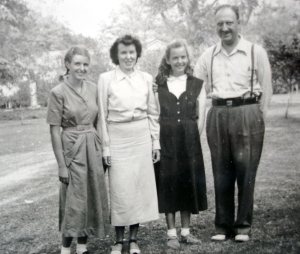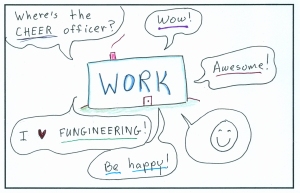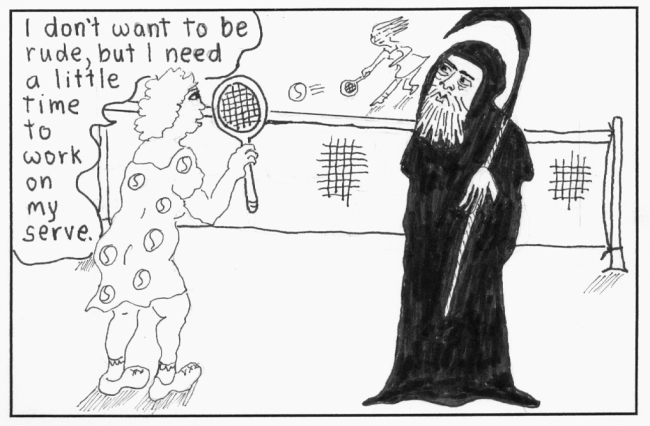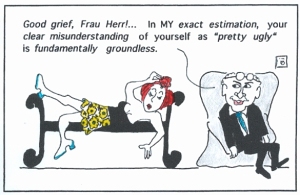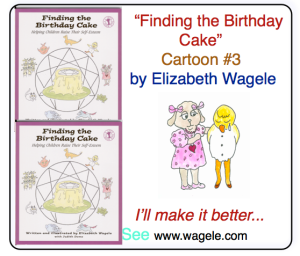The Enneagram for Teens
May 1, 2015 — Elizabeth WageleWho is the Real Me?
March 11, 2014 — Elizabeth WageleHave you ever wondered about the difference between who you are and who you’re pretending to be? I’m searching my earliest memories, when my environment had the least impact on me, to help me find out.
• My love of music goes back forever. I had to have been born with it. This points to preferring the feeling side of life—the arts, beauty, people, psychology, etc. There’s not much argument against the MBTITM preferences (introversion and extraversion, feeling and thinking, for example) being inborn; I believe I’ve also been individualistic, focused on possibilities, and empathic from the beginning.
• When my older sister and my mother screamed at each other, did I freak out and cringe behind the closed door because I naturally disliked conflict? Or did I dislike conflict because their screaming traumatized me? I think I have the anti-conflict gene, if there is such a thing, which Enneagram 9-Peace Seekers and 5-Observers (my type) share. I thrive on peace and dislike drama in my life.
• Football players and wrestlers like rough contact, even getting hurt, and don’t usually mind trading insults. This is not the real me for sure! I’m as far as one can get from typical players of contact sports, often 8-Asserters in the Enneagram.
• Are you too lazy to spend 55 minutes beautifying yourself every day, as the average woman does? My mother, a 2-Helper, wasn’t. She put on lipstick, powder, rouge, and eye makeup every day, finishing by brushing mascara on her two or three white hairs as a quick cover up. She never allowed me to touch her shiny auburn hair. When I see apes bond by running their fingers through each other’s hair, looking for dirt and parasites, the feeling of disappointment comes back. My mother’s interest in her appearance influenced my attitude. I’m not totally lacking in vanity, but I don’t spend much time on it.
• Whenever my mother and I passed through the huge main doors of ZCMI, the big department store in Salt Lake City, she would beeline it to the nearest set of mirrors. We could not talk until she was satisfied with her lipstick, powder, and the angle of her hat. Every so often she’d spot another mirror and recheck herself. Would my mother be as interested in mirrors if she happened to be ugly instead of pretty? Wondering this led me to thinking it would be fairer if humans didn’t have bodies. I wished we could be spirits and relate to one another purely from our inner selves, a wish I almost forgot about when puberty set in.
• My father, a 5-Observer and a scientist, was a role model to me for thinking logically—and he did not suffer fools gladly. I’m thankful I picked up his respect for the intellect, but maybe I tricked myself into thinking I could also be strong and smart like him if I were more critical of others. Being like him would compensate for feeling weak. Now, however, I am more interested in being kind than in one-upping anyone. Being true to my real self by being empathic beats having a false sense of strength.
Visit http://wagele.com to check out my books, CD, cartoons, essays, music, and Famous Enneagram Types.
See Are You My Type, Am I Yours? on Amazon.com
Visit The Happy Introvert – a Wild and Crazy Guide for Celebrating Your True Self on Facebook.
Projecting Self-doubts on Others
January 14, 2014 — Elizabeth Wagele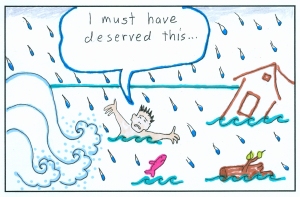 He “blamed” a restaurant after he lost his house.
He “blamed” a restaurant after he lost his house.
Seth’s house washed away in a storm. He lost everything, including valuable paintings, antiques, and computers containing all his writings.
In the nineteen years since he designed and built his dream house, several floods have come close and terrified him. Recently he woke up to the sound of rushing water and began filling sandbags. All his neighbors evacuated but he stayed to fight. The neighbors, who had collected together in a safe place, thought he had died. Some scolded him for taking a dangerous chance.
After listening to the details of his experience, his friend Linette did Seth a favor, she thought, by telling him about the new take-out restaurant that delivers a hot meal in less than ten minutes for $6.00, thinking he could use such a convenience as he rebuilds his life. To Linette’s surprise, however, Seth became angry and attacked the restaurant: “This place is delivering food to 3 year olds who can’t cook it themselves!” he ranted. “Restaurants have to make sure they never run out of food, so they waste a lot of it. People these days don’t even know how to cook their own meals!” And he boasted that he only shops for food every two weeks. Linette felt his anger was directed partly to her, as if he was telling her, “I-have-all-the-answers-so-why-are-you-wasting-my-time?”
Perhaps Seth’s sudden burst of moral superiority was an unconscious attempt to feel better about himself after his loss. Suffering a natural disaster can result in feelings of self-doubt and shame. “I got picked on because I’m a loser.” Without quite realizing it, we try to feel okay by comparing ourselves to others, tearing someone or something down to inflate ourselves and prove our worth.
Linette felt Seth was browbeating her and calling HER one of those 3 year olds. She wanted to keep the peace, however, because Seth had just undergone a trauma. So she struggled to keep her mouth shut.
Seth seemed to be making sure Linette, and more to the point, HE (Seth), knew he was capable and could handle everything. In Enneagram terms, Seth, an independent 5-Observer, has a strong 4-Romantic wing and a need to feel special. He needed more attention than he was getting concerning his loss and his survival.
Linette eventually realized Seth had lashed out in response to stress, fear, and shame. Scolding her and “her restaurant” was a projection—a way of scolding himself for putting himself in harm’s way. She realized his need to boost himself up had little or nothing to do with her. When she next saw him he was more in touch with his grief. Instead of lashing out he expressed his real feelings, that he was depressed and overwhelmed.
Visit http://wagele.com to check out my books (including The Enneagram of Grief), CD, cartoons, essays, music, and Famous Enneagram Types.
Visit the “Are You My Type, Am I Yours?” page on Face Book.
Do You Prefer Having Fun at Work or Working at Work? Part II
December 31, 2013 — Elizabeth WageleThis is Part II of a blog based on New York Times’ Op-Ed Contributor Oliver Burkeman’s article, “Who Goes to Work to Have Fun?” 12-11-2013. How Enneagram types fit into fun at work – or not—are my own additions. Burkeman wrote, “Psychologists have shown that positive-thinking affirmations make people with low self-esteem feel worse; that patients with panic disorders can become more anxious when they try to relax; and that an ability to experience negative emotions, rather than struggling to exclude them, is crucial for mental health.”
One reader commented: “Last year, in a conversation with the young adult son of a friend, I asked him if he would like it if his generation just stopped with the ‘awesome!’ for a little while and was able to express real feelings. He looked at me like he wanted to cry and nodded his head yes. As I see that generation with its forced cheerfulness I wonder if they know how inauthentic they’re
being with themselves.” – Lute, Broooklyn
The Burkeman article continues, “And these are just the hazards of trying to enforce happiness on oneself: Matters are surely more fraught when the person doing the enforcing is a manager with possible ulterior motives, such as discouraging too much focus on low wages or inherently unfulfilling work.”
These companies force you to go to happy hours and then use your “friendship” against you when “asking” you for things later on. When I was an employee, I knew very well what made me happy. Doing a good job, producing a quality product, receiving a fair day’s wages for a fair day’s work, going home each night believing I’d done something of value during the day and that both the customers for my efforts and my peers and supervisors recognized the value I added; earning my living and the respect of people whose own work I valued. What did not make me happy included pizza parties, Employee of the Month and similar contests… – ACW New Jersey
The Eneagram types most likely to be managers are the 3-Achiever and the 8-Asserter. Of course, these types may or may not be ethical.
“Instead of striving to make work fun,” Burkeman said, managers should concentrate on creating the conditions in which a variety of personality types, from the excitable to the naturally downbeat, can flourish. That means giving employees as much autonomy as possible, and ensuring that people are treated evenhandedly.” The Enneagram 4-Romantic, a sensitive type, would especially appreciate this. “According to a recent Danish study, lack of fairness at work is a strong predictor of depression, and even heavy workloads don’t bring people down, provided their bosses are fair.
Another comment from a reader: “If a fungineer shows up at the water cooler at my job it will be very difficult to treat them with respect… If corporate thinks they can ramrod happiness down our gullets with trite mantras they ignore at their peril our basic intelligence in favor of another device aimed at boosting quarterly productivity. A poorly dressed Trojan horse indeed; invading our emotional privacy under the guise of caring about employees feelings.” – Morgan S, Atlanta, GA
And: “I suspect a lot of this “Fungineering” movement is aimed at Millennials who are extending adolescence to hitherto unrealized horizons. Work should be engaging, rewarding, fulfilling and pay the rent. If it’s not that, a foosball tournament with microbrews won’t keep employees.” – NYC
Article: “Not that you’d necessarily want an office full of optimists” (3-Achievers, 7-Adventurers, and 9-Peace Seekers), “even if that were achievable. People who are oriented toward ‘defensive pessimism’ play a valuable role, preparing organizations for worst-case scenarios.” These would mainly be 6-Questioners in the Enneagram, who look out for safety.
“And if your business card describes you as Head of Fungineering, or Chief Cheerfulness Ninja, or Vice President of Wow, please skip the next company paintballing weekend, and use the time to ask yourself a few tough questions instead.”
Visit http://wagele.com to check out my books, CD, cartoons, essays, music, and Famous Enneagram Types.
See “The Career Within You – How to Find the Perfect Job for Your Personality” using the Enneagram.
Visit the “Enneagram Made Easy” page on Face Book.
Young People Talk about the Enneagram and Death, Part I
September 24, 2013 — Elizabeth WageleA Perfectionist talks to Death, from “The Enneagram of Death.”
Four years after his father died, author and psychiatrist Mark Epstein’s mother told him she was still upset. This conversation pleased him because, he said, “grief needs to be talked about. When it is held too privately it tends to eat away at its own support.”
Epstein says in “The Trauma of Being Alive,” (New York Times 8-4-13), “Trauma isn’t just the result of major disasters. It does not happen to only some people. An undercurrent of it runs through ordinary life, shot through as it is with the poignancy of impermanence… If we are not suffering from post-traumatic stress disorder, we are suffering from pre-traumatic stress disorder. There is no way to be alive without being conscious of the potential for disaster. One way or another, death (and its cousins: old age, illness, accidents, separation and loss) hangs over all of us… “
Trauma was also a theme of the panel of 9 people mostly in their 30’s I had assembled to talk about death, fear, and grief at the 2013 International Enneagram Conference last August.
Earl, the 1-Perfectionist, was concerned about his need to leave the world better than he found it. “I’ve always had this sense of mission and zeal. I want to have an impact. In the background I desire to make improvements and bring forth a new perspective. My fullest form of self-expression is to change things. I don’t want my mission to be cut short. Death is the point that, whatever you’ve done by then, you’re done.
“My own death seems like a zen or transition point, but physical and mental decline scare me. Back in my 20s I was depressed and felt a disconnect between the way I wanted to live and the way I was. It’s painful to think about losing my mobility, my capacity to enjoy activities. I hope to think rationally, have a clear sense of judgment, and see things how they are. Realizing how much we regret decisions we’ve made and fear living with the consequences are big fears for Ones in general. This sheds light on death itself. You die and there’s nobody there and no more regret. A lot of times when I’m anxious about something I can’t control (job security), I’ll get tunnel vision and concentrate on what I CAN control. Like the 6-Questioner, I’ll ruminate, think, and keep busy.”
Linda, the 2-Helper, said “I relate to the 6-Questioner’s mental anxiety. I make up that my husband will die and I’ll be alone. I am the one with health issues, but the habit of the Helper is to focus on the other. He eats a lot of Snickers so I’m always criticizing his diet in my head. I go on rants about nutrition and how we’re killing ourselves with toxins. I’m a health nut because I have rheumatoid arthritis—I’m the one who has had to change my diet.
“When I was 9 years old a horse kicked me in the head. I went to a beautiful place where there was no separation. There was no light but it wasn’t dark. No pain. Peaceful. Infinite. I can’t imagine anything more amazing. My whole life has been about getting back there. There’s nothing to fear. We have moments of heart connections where there’s no separation. The thought of dying is a comfort. I think about it a lot and look forward to it.”
See Part II (types 3, 4, and 5) on Oct. 8.
Look for my blog about healing PSTD in Psychology Today Oct. 1.
Visit “Are You My Type, Am I Yours?” on FB and check out my work on wagele.com.
The New DSM: Abnormal is the New Normal
August 13, 2013 — Elizabeth WageleUnder the Diagnostic and Statistical Manuel (DSM), which defines mental illness in the U.S., half of us have a diagnosable mental disorder.
It should come as no surprise that many who profit financially from mental illnesses would encourage broadening the definitions in the DSM-5. This benefits therapists because insurance covers clients if their diagnosis is in the DSM.
According to Robin S. Rosenberg in his article in Slate, “Abnormal is the New Normal,” our odds of having a mental disorder in our lifetime are greater than 50%, based on the new DSM-V. “For decades, mental health clinicians, physicians, the U.S. surgeon general’s office, and various state and local agencies have been advocating for better detection of mental illness. If we are better at spotting it, we can treat it. And if we detect it earlier, we can hopefully intervene to reduce the intensity and/or frequency of symptoms. For instance, people who decades ago may have had undiagnosed attention deficit hyperactivity disorder, depression, or substance abuse are now more likely to have their problems recognized and diagnosed. But the increased awareness and detection translates into a higher rate of mental illness.”
Various tests show our population is getting more anxious, more neurotic, and more narcissistic.
We’re more willing to see mental illness in ourselves and others. Many normal problems that were once considered healthy are now classified as mental illness, partly because the DSM keeps increasing the number of disorders, from 106 in 1952 to 297 in DSM IV.
Some of the disorders added are medical, not psychological, such as “breathing-related sleep disorder,” caffeine intoxication, and caffeine withdrawal.
Even shyness, worrying, and grief are now considered pathological.
When insurance pays for treatment, a diagnosis is necessary. So you can see why therapists like it when more problems qualify. The more problems, the more the pharmaceutical companies profit, too. 70% of the DSM-5 task force members have financial ties to the pharmaceutical industry. Also, people want quick fixes to their problems and mental diagnoses enable them to become more eligible for government services.
Rosenberg adds, “…Having a diagnosis gives a name to the suffering we feel and the hope that with a label can come relief… Hope is essential. But I’m not sure that ultimately labeling half of us with a mental disorder is the best way to give people realistic hope. Having a diagnosable mental illness has almost become the new ‘normal.’ As a society, we have an opportunity to think about how we define mental health and illness. It shouldn’t only be up to the authors of the DSM.”
In my blog last May in Psychology Today, “Criticism of the DSM-5 and a Suggestion, II,” I suggested the DSM completely change the way it diagnoses problems by using the Enneagram as a model for not only mental illness, but also for a comparison with people who are healthy mentally. Each of the 9 Enneagram personality types can be described in stages from healthy to unhealthy. The DSM would be tied to a continuum of these 9 basic features. For example, the 6-Questioner when healthy is alert, often witty, and concerned about safety. This personality descends when unhealthy into paranoia. The healthy 1-Perfectionist wants to do what’s right and is well-organized. People of this type who are unhealthy may suffer from obsessive/compulsive disorder. While most pathologies could be compared to the normal personality, schizophrenia and some other illnesses may lie outside of this model.
Read my Psychology Today blog of 8-6-13, Pessimism and Enneagram Type 6-The Questioner.
Visit http://wagele.com to check out my CD, cartoons, essays, Famous Enneagram Types, and books:
“The Enneagram Made Easy,”
“Are You My Type, Am I Yours?”
“The Enneagram of Parenting,”
“The Happy Introvert,”
“Finding the Birthday Cake“ (for teaching the Enneagram to young children),
“The Career Within You,”
and “The Enneagram of Death.”
My CD, “The Beethoven Enneagram,” is available only through Amazon.com. My books can be ordered from independent book stores or Amazon.com.
Invitation to Workshop: “Finding Our Way Home” February 9
January 8, 2013 — Elizabeth WageleDear Reader,
If you or someone you know would like to start the year exploring how we Love and how we engage with Others and with Life itself… 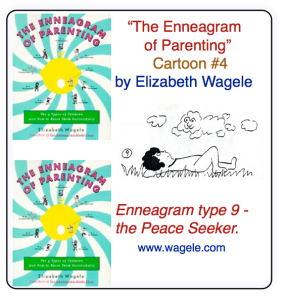
if you are looking for an adventure… 
or healing…
this workshop in Chicago based on my newest book may be for you and/or your friends…
I’d like to invite you to:
Finding Our Way Home
Co-presented by Ruthie Landis and
guest author, artist, and musician Elizabeth Wagele
Saturday, February 9, 2013
9:30 a.m.- 4:30 p.m.
Our tango with Loss, Grief, and Dying offers us a
poignant opportunity to know our True Self more fully,
explore how we Love, and how we engage with Others and with Life itself.
Come join us for a “happening”; a safe, playful, and provocative day of learning and connecting with others, while we find ways of looking at that which we fear and avoid, our own mortality. As the centerpiece of the day, prolific author, artist, and pianist, Elizabeth Wagele will offer her latest book, The Enneagram of Death, as well as her live music and comic perspective to the facilitated workshop experience. Coming together, actors and dancers, people of all ages and backgrounds, with curiosity and open hearts, will share an unforgettable and truly enlivening day as we each continue to
Find Our Way Home.
at The Ethical Humanist Society, 7574 N. Lincoln Ave. Skokie, Illinois
Pre-registration-$75———Register after January 25- $85
(includes signed book and light lunch)
To register email ruthienergy@ruthlandis.com or PayPal at ruthlandis.com
Yours truly,
Elizabeth Wagele
http://www.wagele.com for information on The Enneagram of Death and other books and essays.
“Questioners” (Type 6) as Children
February 14, 2012 — Elizabeth WageleNow read about all the nine Enneagram types as children on this WordPress blog under the category “Enneagram Books and Children.”
Personality typology explains why we frustrate each other. It’s not always because we don’t think straight or don’t have common sense, it’s often because we’re born with different ways of looking at the world. This produces different values. When we try to walk in others’ shoes (when we learn the Enneagram), our frustration eases and dealing with our family members, students, teachers, or fellow students becomes easier.
The Enneagram personality system had been around for about twenty years. At first it was kept a secret. Its leaders thought the world couldn’t handle it. Then the positive ones among them exerted more influence. They wanted to share their newfound prize and tell the world about it. Classes and books about the Enneagram sprang up starting mainly in 1987.
In 1997, I wrote the first book for using the Enneagram with children in families and schools, The Enneagram of Parenting. Each type has a different learning style, for example, and different paces, outlooks on life, and needs to nurture and be nurtured. In 2007, I wrote the first book for young children to learn the Enneagram by reading it themselves or having it read to them, Finding the Birthday Cake. Both books are full of cartoons and are easily accessible.
Questioner children have busy, alert minds, are suspicious of flattery, and are always on the lookout for danger. They can be quick-tempered, brave, and anti-authoritarian. Some are assertive, others are timid. Stevie Six is a character from Finding the Birthday Cake:
Here is a test from Finding the Birthday Cake:
See my list of Famous People’s Enneagram and MBTI types.
More Famous People are on my Psychology Today blog and my WordPress blog.
See my Happy Introvert and Creative Enneagram on You Tube.
How Young Were You When You Chose Your Career?
January 31, 2012 — Elizabeth WageleWere you forced to take over the family business? Did you know you wanted to do anything but what your parents did? Did you want to join a circus when you grew up? What did you learn by good or reverse example from your family career-wise?
This may sound strange to some of you and logical to others: my psyche picked out my passion in life, which turned into my first career, by the time I was four years old. It informed me, without my knowing it, by means of a dream. I tell the dream in my upcoming book on death and dying so I won’t tell it here. Suffice it to say that the dream drove me into my inner world in waking life and to actively pursue my love for music. My second career of writing came much later. I’m an Observer in the Enneagram.
My Helper type mother was interested in art but didn’t have a career other than homemaker. One of her brothers, possibly a Perfectionist, worked for Lockheed Airplane Company. He knew he wanted to be an electrical engineer from the age of six. The other brother, a Peace Seeker, sold iron or steel. Their father started out as a clerk in a bank in Cripple Creek, CO. He was most enthusiastic about selling real estate, but wasn’t very successful.
My father, an Observer with a Questioner wing, was a metallurgist, figuring out how to extract minerals from ores by means of chemistry and physics. He worked for the Bureau of Mines. Then the University of California hired him as a professor and he consulted on the side for the Union Pacific Railroad. He knew from an early age that he wanted to be a scientist.
His brother-in-law, an Asserter, ran a successful business that manufactured flowerpots. He was protective of and kind to his employees. His wife, my father’s sister, was an Adventurer. She didn’t have a job. She did something naughty. She told us she played bridge a lot, but she was really going to casinos to gamble. My father’s other sister, a Questioner, was one of the first women to be an executive in a large clothing company, Lerner’s. This was in the 1930’s and 40’s and later. In fact, she’s my only aunt or grandmother who had a career. My father’s brother, a Peace Seeker, was an attorney for the Pentagon. He negotiated contracts with outside companies.
My father’s father, an immigrant from Odessa, Russia, started out selling junk in Omaha Nebraska. He moved his family to Salt Lake City around 1909, opened a bar with gambling in the back, and invested in mines. He made a lot of money and lost most of it in the crash of 1930.
When he was a little boy, my husband, Gus, didn’t want to work when he grew up as a reaction to his parents’ pressuring him to be successful. He ended up working hard, however. An Observer, he majored in art at Cal and loved to paint. He became a high school teacher of Educationally Handicapped students, preferring that to history, which he had started out teaching.
His father, a Perfectionist, started out as a teller during the Depression. Someone advised him to go to college, which he did, and he eventually rose to bank vice president. One of Gus’ grandfathers sold pianos. The other, a German immigrant, was a self-taught baker. When he had a bakery in Oakland, young Jack London delivered bread for him.
For more famous types, see my list on wagele.com, my Psychology Today blog, and my WordPress blog.
Also, check out my videos on You Tube: The Happy Introvert and The Creative Enneagram
Richard Branson, Enneagram Adventurer, OWS Backer
December 13, 2011 — Elizabeth WageleSir Richard Branson (born 1950 in England), is the multi-billionaire, risk-taking entrepreneur of the Virgin Group (including Virgin Records, Virgin Airlines, and hundreds of other ventures). He’s an Adventurer in the Enneagram personality system: “My interest in life comes from setting myself huge, apparently unachievable challenges and trying to rise above them.”
| Adventurers are often idealists. Branson protested the Sudanese government expulsion of aid groups from the Darfur region. He joined the project Soldiers of Peace, a movie against all wars and for global peace. He’s a signatory of Global Zero, a non-profit international initiative to eliminate all nuclear weapons worldwide. |
Branson pledged to invest the profits of Virgin Atlantic and Virgin Trains (about $3 billion) in research for environmentally friendly fuels.
Though he belongs to the wealthy 1%, he says he identifies with the 99%. He said, “A few greedy people in the banking community nearly brought down the world, and that’s made people angry. I think not just the banking community, but the whole of the business community needs to make sure that capitalism puts on a genuinely positive face and gets out there and helps change the world to an extent that the Occupy Wall Street demonstrators can feel they’ve done their jobs and go home. It’s up to every single person who works in business to play their part, even in a small way, to rectify the damage that’s been done. What they’re campaigning for is for businesses to become forces of good. If businesses can become forces of good and can grow hearts and get out there and not just be money-making machines, then, you know, I think that will be all for the better.”
Hmmm. That statement sounds a bit naïve to me. Adventurers are known for their optimism and sometimes their over-optimism. Given how entrenched the corporations and banks are with the government and the rest of the powerful, a superficial change of face isn’t relevant. As of now, capitalism has failed. A genuine change must take place deep down in the country’s gut. That’s one of the reasons we need a prolonged period of turning inward to percolate new solutions. They may include many of Branson’s ideals: non-violence, empathy, ecology; but a new way of managing our money is needed. I’m not going to hold MY breath waiting for businesses to turn kind so the demonstrators can go home satisfied. We need patience and time to think. We need to use our introversion: contemplation, planning, thinking things through. We need to do research and use our logic. We need to be in the streets talking and demonstrating, and at home (if we’re lucky enough to have a home) writing about these things. We’ll make our lists and demands and act on them later.
In 2006, Branson formed Virgin Comics and Virgin Animation, an entertainment company focused on creating new stories and characters for a global audience. The company was founded with author Deepak Chopra and others. Branson launched the Virgin Health Bank in 2007, offering parents-to-be the opportunity to store their baby’s umbilical cord blood stem cells in private and public stem cell banks.
In 2007, Branson also announced a new Global science and technology prize—The Virgin Earth Challenge—to encourage technological advancements for the good of mankind. It will award $25 million to the individual or group who can demonstrate a commercially viable design resulting in the net removal of anthropogenic, atmospheric greenhouse gases each year for ten years or more without harmful effects, contributing to the stability of the Earth’s climate. Branson will be joined in the adjudication of the Prize by Al Gore and others.
Adventurers are sometimes called Epicureans: Branson and the Natirar Resort development in New Jersey opened in 2009 with the Ninety Acres Culinary Center. It includes a restaurant run by chef David Felton, cooking school, wine school, working farm, luxury resort and spa.
Adventurers love fun and excitement: In 2010 Branson became patron of the UK’s Gordon Bennett gas balloon race, which has 16 hydrogen balloons flying across Europe.In January 1991, he crossed the Pacific from Japan to Arctic Canada, 6,700 miles, in a balloon, breaking the record, with a speed of 245 miles per hour. In 2004, Branson set a record by travelling from Dover to Calais in a Gibbs Aquada in 1 hour, 40 minutes and 6 seconds, the fastest crossing of the English Channel in an amphibious vehicle. In 2010 he tried for the world record of putting a round of golf in the dark at the Black Light Mini Golf in The Docklands, Melbourne, Australia. scored 41 on the par 45 course.
Richard Branson lives the life of a 1 per center but he says he’s with the 99%. He’s contributing to make the world a better place on many levels. He’s a good example to other super wealthy people, who often think they’re above concerning themselves with the problems of the world.
See my website, Wagele.com and my blog on Psychology Today for more famous Enneagram types.
